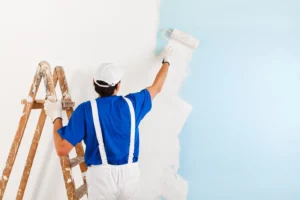Residential painting is a professional service that painters provide to homeowners. It includes interior and exterior painting for homes, apartments, condos, and other living spaces.
The type of paint used in a residential project varies depending on the space. For example, bedrooms are low-impact areas that can use any paint, including flat or matte latex. Click here to Learn More.

Residential painting is a service that involves the professional application of paint to enhance living spaces. It is a highly visual profession that requires a blend of skill, creativity, and design sensibility. Residential interior painters are responsible for transforming ordinary living environments into visually stunning spaces that reflect the homeowner’s tastes and lifestyle preferences. Choosing the right paints and maintaining good maintenance practices are critical for the success of residential painting projects.
The scope of a residential painting project depends on the type of house being painted. For example, a single-family home may be painted with oil-based or water-based paints while an apartment complex or condominium is typically coated with latex-based paints. It is also important to consider the size of the living space and whether it will be painted inside or outside.
A residential painting project can be complicated and require a great deal of preparation and attention to detail. It is crucial to hire a reliable painting contractor that has the experience and expertise to ensure that your project goes as planned. The contractor should provide a detailed quote that outlines the costs of materials, labor, and unforeseen expenses. This will help you budget for the project and avoid any surprises down the road.
Moreover, residential painting projects require a variety of tools that homeowners may not have access to. A professional painting company has a treasure trove of tools that will help them complete the job quickly and efficiently. These tools include high-quality brushes, rollers, spray guns, and trays for storing paint. These tools can make the difference between a professional-quality finish and an amateur one.
Additionally, a quality residential painting contractor will stay abreast of the latest trends in color and ideas. This will allow them to create a unique look that is both stylish and timeless. These trends can include everything from calming earth tones to bold jewel colors, and they can be used to elevate the aesthetics of any room in the home.
Residential painting contractors have experience communicating with homeowners and preventing damage to furnishings, floors, and other surfaces. They also understand the different materials and surfaces that need to be painted, such as wood, tile, vinyl, and drywall. In addition, they are familiar with the appropriate paints for each surface, how to properly prepare those surfaces, and the best techniques for applying the paint to achieve a beautiful, professional finish.
Safety is a major concern during any type of painting project. Paint fumes and flecks of paint can cause eye irritation, and it’s important to protect yourself and others with the proper safety gear. Wearing a face mask will help prevent breathing in these chemicals. It is also a good idea to wear goggles to prevent splashes in the eyes, and gloves and a coverall will protect your skin from any irritants. Finally, make sure that the area is well-ventilated so that harmful vapors do not build up. Fans, spray booths, open doors, and windows will circulate fresh air and dilute harmful vapors.
A residential painting project takes place in a homeowner’s home, so the working environment is much more controlled than on a commercial jobsite. In a commercial painting project, there may be a lot of foot traffic and business is likely to continue during the work, so the jobsite needs to be kept safe with barriers and signs to direct people away from the work areas.
In a residential painting project, the focus is on meeting the homeowner’s vision and the careful application of the paint to meet those goals. In commercial projects, a greater emphasis is placed on productivity and efficiency because delays can be costly for the business.
Both types of painting require a lot of supplies, but the quantity and types of supplies required differ. Generally, residential painting requires basic equipment that is similar to what any homeowner would purchase on their own, including things like drop-cloths, step ladders, rollers, paint trays, and paint brushes. In contrast, commercial projects often require more heavy-duty materials and equipment since the space is larger.
Residential painting focuses on enhancing the aesthetics of homes and meeting homeowner preferences. In contrast, commercial painting aims to create an inviting and brand-appropriate environment in non-residential properties such as offices, shops, restaurants, warehouses, etc. While both types of painting play a crucial role in enhancing the appearance and durability of properties, there are many different factors that make them distinct from each other.
For example, the size of the project is one of the biggest differences between commercial and residential painting. Commercial projects tend to be larger in scale and require a greater number of surfaces than residential painting projects do. As a result, commercial painting requires more advanced equipment and a higher level of expertise to ensure that the work is completed within the required timelines. Additionally, the use of industrial-strength paints with high sheen levels can add to the length of time the job takes to complete.
Another important difference between commercial and residential painting is the working environment. Commercial painting is typically conducted during business hours, so it is essential that the job be completed without disrupting the flow of business. This requires a great deal of planning and a focus on productivity to meet deadlines and avoid costly delays.
In addition, environmental regulations and protocols must be followed during the process. This includes proper storage and disposal of hazardous materials. Additionally, commercial painters are often required to wear additional protective gear to ensure their safety.
When it comes to working on the exterior or interior of a home, residential painters have a lot more experience than their commercial counterparts. They know how to prepare the property and apply the paint using a variety of techniques for long-lasting results. Additionally, they are able to provide valuable insights into how the work will impact the home’s overall look and feel.
Residential painters also have more experience communicating with homeowners and providing them with helpful tips on how to protect their belongings during the painting process. As a result, they can help the homeowner achieve the desired results with minimal disruption to daily life.
Residential painting is a service provided by professional painters who help homeowners achieve a new and updated look for their home. This type of painting involves surface preparation, such as filling cracks and sanding, along with the application of primer and paint to achieve an aesthetic and protective finish. The service is typically performed on a house’s interior or exterior walls, cabinets, and trim. Residential painting is a key part of homeowner maintenance and can improve the overall value of a property.
There are several factors that influence the time required to complete a residential painting project. These include the size of the house, the number of rooms to be painted, and the type of paint used. It is important to consider all these factors when planning a residential paint project. Having realistic expectations about the duration of the project can save both time and money. It is also helpful to plan for the inconvenience of having painters around, such as moving furniture or dealing with paint fumes.
Unlike commercial painting, which is typically done in large spaces with heavy equipment, residential painting is usually conducted in small to medium homes and apartments. This type of painting requires a different set of skills and specialized materials. Painters who specialize in residential painting usually use rollers, painting trays, step ladders, and cleaning materials that are similar to what is available at home improvement stores. In contrast, a commercial painter often uses pressure washers and specialized brushes that are designed for high-rise buildings.
Residential painters are responsible for meeting the vision of the homeowner, and they can do this by choosing colors, treating surfaces properly, and applying the paint in an efficient manner. It is also important for them to take into account the weather conditions when working on exterior painting. In addition, they need to be mindful of the homeowner’s schedule and the amount of time that will be needed to complete the project.
The length of time it takes to complete a painting project can be influenced by a variety of factors, including the size of the home, the type of paint used, and the amount of prep work that needs to be done before the actual painting begins. It is crucial to plan ahead and hire a professional team to ensure that the job is completed on time.

